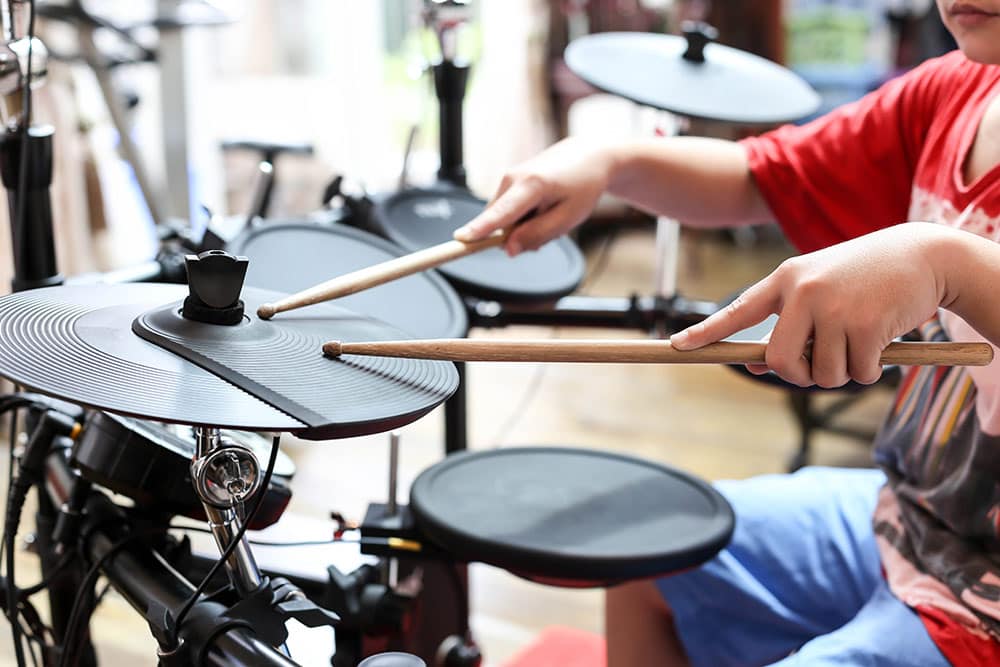To start learning drums at home, invest in a beginner drum set and basic learning resources. Practice consistently to build skills efficiently.
Playing the drums is an exciting journey that can be pursued from the comfort of your own home. Whether you’re a complete beginner or looking to improve your drumming skills, starting your drumming journey at home can be convenient and enjoyable.
With dedication and practice, you can develop rhythmic abilities and impress yourself with your progress. By setting up a practice space, investing in a beginner drum set, and utilizing online tutorials and lessons, you can kickstart your drumming journey right from your home. Get ready to embark on a musical adventure as you learn to play the drums on your terms.

Credit: www.youtube.com
Benefits Of Learning Drums At Home
Discover the benefits of learning drums at home with a convenient and flexible approach. Start your journey to becoming a skilled drummer at your own pace and enjoy the comfort of practicing in a familiar environment.
Convenience
Practicing drums at home offers flexibility and ease of access.
Cost-effective
Learning drums at home can be budget-friendly, saving money on commute and lesson costs.

Credit: www.schoolofrock.com
Setting Up Your Drum Practice Area
Setting up your drum practice area is crucial in creating a conducive environment for effective learning.
Choosing The Right Space
- Find a quiet spot away from distractions.
- Ensure adequate room for your drum set.
Arranging The Equipment
- Place the drums in a circular layout for better reach.
- Adjust the height and angles of each drum and cymbal.
Essential Drumming Techniques For Beginners
Learning the drums can be an exciting and rewarding experience, especially when you have the option to practice at home. If you’re just starting out, it’s crucial to focus on essential drumming techniques that lay the foundation for your future progress. In this article, we’ll explore three key techniques that beginners should master: proper drumstick grip, basic drumming exercises, and the importance of maintaining a consistent practice routine.
Proper Drumstick Grip
One of the first and most essential techniques to learn as a beginner drummer is the proper drumstick grip. Holding the drumsticks correctly not only improves your finesse and control but also helps prevent fatigue and injury. Here’s how to ensure you have the correct drumstick grip:
- Hold the drumstick with your dominant hand, making sure it rests between the base of your thumb and the first knuckle of your index finger.
- Your thumb should be positioned on the top of the stick, exerting a subtle pressure while the remaining fingers wrap around the stick.
- Avoid gripping the drumstick too tightly, as it limits your flexibility and can cause muscle strain.
Mastering the correct drumstick grip may take some practice, but it’s an essential foundation for developing accurate drumming technique. By maintaining this grip throughout your drumming journey, you’ll build a solid foundation for more advanced rudiments and drumming styles.
Basic Drumming Exercises
To progress as a drummer, you must familiarize yourself with basic drumming exercises that strengthen your coordination and timing skills. These exercises will not only enhance your rhythm but also help build muscle memory. Here are a few fundamental drumming exercises to get you started:
- Single Stroke Roll: Alternate your left and right hand while striking the drum in a continuous motion.
- Double Stroke Roll: Play two strokes with each hand consecutively, maintaining a smooth and controlled motion.
- Paradiddle: A combination of singles and doubles, the paradiddle consists of four notes played in the sequence RLRR LRLL.
When practicing these exercises, begin slowly and focus on maintaining a consistent rhythm. Gradually increase your speed as you become more comfortable, but always prioritize accuracy over speed. Regularly incorporating these exercises into your drumming routine will enable you to develop the necessary technique and precision for more complex drum patterns down the line.
Learning Drum Notation And Reading Sheet Music
Learning drum notation and reading sheet music are essential skills for any aspiring drummer. Understanding the intricacies of drum notation and being able to read sheet music can significantly enhance your drumming capabilities. By mastering these skills, you will be able to learn new songs faster, communicate effectively with other musicians, and expand your musical repertoire. In this blog post, we will explore the fundamentals of drum notation and sheet music reading, providing you with the necessary knowledge to start learning drums at home.
Understanding Drum Notation
Drum notation is a system of writing down drum patterns and rhythms using specific symbols and notations. This allows drummers to communicate and replicate complex rhythmic patterns accurately. To start understanding drum notation, familiarize yourself with the basic symbols and their corresponding sounds. Practice playing these patterns on your drum kit while reading the notation to reinforce your understanding.
Practice Reading Sheet Music
Reading sheet music is a valuable skill that allows drummers to interpret musical compositions accurately. Begin by learning the names and durations of different notes and rests. Practice sight-reading simple sheet music to improve your fluency. As you become more proficient, challenge yourself with more complex compositions to enhance your reading skills.
Developing A Drumming Practice Routine
When it comes to learning drums at home, developing a drumming practice routine is essential for progress. Setting clear goals, creating a schedule, and maintaining consistency are crucial components of an effective practice routine.
Setting Goals
Begin by setting specific and achievable goals for your drumming practice. Whether it’s mastering a particular beat, improving your speed, or learning a new technique, clear goals provide direction and motivation.
Creating A Schedule
Establish a regular practice schedule that fits into your daily routine. Consistency is key to improvement, so aim to practice for a set amount of time each day. Consider using a timer to keep track of your practice sessions.

Credit: www.musichouseschool.com
Frequently Asked Questions On How To Start Learning Drums At Home
Can I Learn Drums On My Own?
Yes, you can learn drums on your own with dedication, practice, and online resources. Start with basic tutorials and gradually progress.
How Do Beginners Start Drumming?
To start drumming as a beginner, get a practice pad and sticks, practice basic drumming techniques, and learn simple drum patterns. Take lessons from a qualified instructor and practice regularly to improve skills. Join a beginner’s band or play along with music to enhance your drumming abilities.
What Is The Easiest Way To Learn Drums?
The easiest way to learn drums is by taking lessons from a qualified instructor. Practice regularly, start with basic beats and gradually build your skills. Use online resources and practice with a metronome to improve timing. Stay committed, patient, and have fun during your drumming journey.
What Should I Practice First On Drums?
Start with basic rudiments to build technique, then practice simple beats and fills. Focus on timing and coordination.
Conclusion
Learning drums at home may seem daunting, but with the right approach and dedication, you can make significant progress. Focus on setting up a designated practice space, investing in quality equipment, and following structured lessons. Keep practicing regularly, challenging yourself, and seeking guidance from online resources or virtual instructors.
Remember, the key is consistency and perseverance. So, embrace the journey, enjoy the process, and soon you’ll be playing your favorite beats like a pro. Happy drumming!